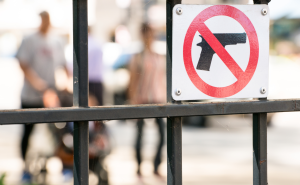Study of Fatal and Nonfatal Shootings by Police Reveals Racial Disparities, Dispatch Risks
Analysis, thought to be one of the first published studies that captures both fatal and nonfatal injurious shootings by police nationally, also highlights risks of well-being checks

A new study from researchers at the Johns Hopkins Center for Gun Violence Solutions and Vanderbilt University found that an average of 1,769 people were injured annually in police shootings from 2015 to 2020, 55 percent of them or 979 people, fatally. The study covered a total of 10,308 incidents involving shootings by police. The Center is based at the Johns Hopkins Bloomberg School of Public Health.
The majority of victims in shootings by police—84 percent overall—were reported as armed with a firearm or other weapon, such as a knife or vehicle, during the six-year study period.
The analysis found that overall, when injuries occurred, police responses initiated by a call to emergency dispatchers were 46 percent more likely to end with a fatal shooting injury than incidents where an officer was already on scene. Calls to police to check on the well-being of individuals were 74 percent more likely to be associated with fatal injury than police responses to an incident where shots had already been fired. This includes wellness checks that did not explicitly involve threats or harm before an encounter with police.
The study was published online March 13 in the American Journal of Public Health.
The new findings also suggest that injury disparities among racial groups are underestimated when looking only at fatal shootings. Among people nonfatally injured in police shootings, victims identified as non-Hispanic Black comprised 29 percent (2,226) of race-identified (those with racial data included in records) injured people in this study. In comparison, a 2015 study examining fatal shootings by police in a single year found that 26 percent of victims were non-Hispanic Black people.
The study found that, relative to white victims, non-Hispanic Black people were disproportionately injured in nonfatal shootings by police and had 35 percent lower odds of fatal injury when shot.
Firearm research often focuses on fatalities, as they are listed as the cause of death and reported to the Centers for Disease Control and Prevention. Currently, there is no database that consistently and reliably tracks nonfatal firearm injuries for the general population. As for shootings by police, reporting by law enforcement agencies to the federal government’s data systems is voluntary, and death certificate inclusion of law enforcement involvement is inconsistent. Researchers say this makes official reporting unreliable. The researchers undertook this study to get a fuller picture of shootings by police.
For their study, researchers manually reviewed publicly available records on police shootings maintained by the Gun Violence Archive that resulted in a fatal or nonfatal injury from 2015 to 2020. The Gun Violence Archive, a nonpartisan nonprofit founded in 2013, maintains a database of fatal and nonfatal gun violence using thousands of sources including media, law enforcement, government, and commercial. Fifteen trained Bloomberg School students and researchers manually reviewed and coded the incidents at least once. The team then cross-referenced fatal incidents with Fatal Encounters, a database that tracks fatal shootings by police officers.
Incidents in which mental or behavioral health conditions were named in association with the shooting comprised 23 percent (2,404) of all shootings by police. Injuries associated with behavioral health needs were more likely to be fatal. Sixty-seven percent (1,611) of all shootings by police involving someone suffering from a mental or behavioral health episode were fatal.
“The data we reviewed suggests that behavioral health calls are a common interaction preceding injurious shootings by police,” says Cassandra Crifasi, PhD, MPH, co-director of the Johns Hopkins Center for Gun Violence Solutions. “We recommend improving social services to make responding to behavioral health calls safer for everyone. Public support is high for these approaches including nonpolice mobile units, diversion to mental health services, and a police and mental health co-responder model.”
The analysis found that the odds of a fatal shooting by police were significantly higher if the victim was armed. In more than half of these fatal shootings—57 percent or 3,356—someone other than a police officer was also armed with a firearm. Overall, 364 (3 percent) of injured people possessed a replica or BB gun and 1,531 (14 percent) were armed with a knife. In contrast, in 955 (9 percent) of shootings, the injured person was not armed.
Of all shootings by police involving no other weapon, i.e., from victims or others, 40 percent of victims (785) were described as non-Hispanic white, 35 percent were non-Hispanic Black, and 21 percent were Hispanic.
“While this study improves our understanding of injurious shootings by police, there is a clear gap in systematic reporting of all shootings by police, fatal and nonfatal,” says Daniel Webster, ScD, Distinguished Research Scholar at the Center for Gun Violence Solutions. “Law enforcement agencies at all levels of government should commit to gathering comprehensive, detailed, and standardized data to inform efforts to prevent future injurious shootings by police.”
The authors note that the study has limitations. Because the analysis relies on media stories, data rely on assumptions of newsworthiness, accurate reporting, and resulting news coverage.
The authors also note that public safety reforms should require reporting nonfatal as well as fatal shootings by police to assess overall impact among groups disproportionately affected.
First author Julie Ward, RN, PhD, MN, conceptualized the study when she was completing her PhD at the Bloomberg School. She is now an assistant professor at Vanderbilt University.
“National Burden of Injury and Deaths From Shootings by Police in the United States, 2015‒2020” was written by Julie A. Ward, RN, PhD, MN, Javier Cepeda, PhD, MPH, Dylan B. Jackson, PhD, MS, Odis Johnson Jr, PhD, Daniel W. Webster, ScD, MPH, and Cassandra K. Crifasi, PhD, MPH.
The study was supported by New Venture Fund, Joyce Foundation, and Robert Wood Johnson Foundation.





